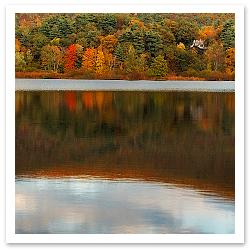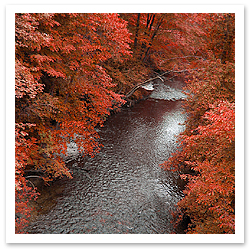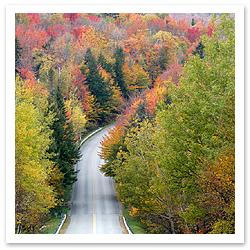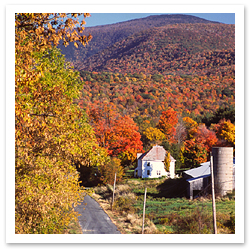It's coming on here in Northwest CT, should be nice for a while.
Here's more from the Fodor's travel wire on foliage following in New England:
New England park rangers and other outdoors-y types are predicting an outstanding fall foliage season this year, though the foliage peak might be a few days later than usual due to the still-lingering traces of summer. The last weeks of September and early October in the northernmost regions of New England are expected to be prime viewing time. Check the Foliage Network for current updates as the season progresses. Here's where to see the best of Mother Nature's annual art show.

For New York-based leaf-peepers who can't break away for a long weekend, Connecticut -- "New England's front porch" -- is a doable day trip.
When to Visit: Foliage season usually begins here in late September and extends through mid-to-late October. Peak color is estimated to be a little early this year -- between October 5 and October 12. But the tourism board suggests that people not fuss and fret about missing the big-color climax, noting sensibly that "visitors will still be able to enjoy a full array of colors even before the peak."
Best Viewing: Take a drive along Connecticut Route 169, a winding off-the-beaten-path road that travels through the rural northeastern corner of the state and has been dubbed one of the ten most beautiful drives in the country. Start your drive in Canterbury, CT, and along the way stop for a meal at the Inn at Woodstock Hill, or tour the Sharpe Hill Vineyard and Winery in Pomfret. If you're driving to Connecticut from NYC, avoid the interstates and take the Merrit Parkway, one of the oldest highways in the country. You'll be guaranteed one of the most impressive foliage shows anywhere.

With 17 million acres of forest, taciturn Maine is downright festive in autumn, when trees put on one of the Northeast's grandest shows. The perkiest hues come from the sugar maple, oak, elm, birch, and ash trees, all native to the state.
When to Visit: Leaves start to turn in the northern part of the state in late September. The southern part of the state is ablaze by mid-to-late October.
Best Viewing: To see the foliage at its best early in the season, take a drive along the Rangeley Lakes National Scenic Byway, which begins on Route 17 in Byron (western Maine) and traverses north to its namesake waterway. Make sure to stop at the Height of Land overlook to wax poetic over the view of five lakes surrounded by colorful mountains. In October, visit Camden, where the blazing-colored hills slope down to a schooner-filled harbor fed by a waterfall in the center of the town. In Camden, drive to the 800-foot summit of Mt. Battie and have a big bowl of chowder and a piece of pie at Cappy's.

The state's tourism board claims that only two places in the world -- New Hampshire and Japan -- have the unique combination of climate and topography that results in particularly brilliant foliage.
When to Visit: In mid-September, the state's mountaintops and lowlands turn a flaming red. From the end of September through the first week in October, the trees are at their peak color in the far northern part of the state. The first two weeks of October are southern New Hampshire's time to shine.
Best Viewing: To view all this wonderfulness, take a drive along the Kancamagus Scenic Byway, which traverses New Hampshire's White Mountain National Forest. The road begins at the junction of I-93 and Highway 112 in Lincoln (near the Pemigewasset River) and goes east until it ends in the city of Conway at the junction of Highway 112 and Highway 16. If you're traveling with kids, stop off at Clark's Trading Post (weekends only through mid-Oct.), a classic cheesy roadside attraction that includes a fire station, a steam locomotive, and trained bears. Or drive to the eastern end of the Byway, park your car, and take a train ride on the Conway Scenic Railroad -- opt for the picturesque Notch route for the full-on fall foliage experience.

The Green Mountain State doesn't even try to live up to its nickname in autumn, when its mountains morph into a multi-colored mosaic. State foresters here are joyfully expecting a spectacular season.
When to Visit: Mother Nature's fall fiesta typically begins in mid September in the northern part and higher elevations of Vermont and progresses southward to lower elevations through mid to late October. But Vermont's small size makes it easy to roam across the state and experience every color stage in just one day.
Best Viewing: Drive the Smugglers' Notch Scenic Byway (Vermont Route 108), which can be picked up about an hour's drive east of Burlington. The super-curvy road brings you up through the foliage canopy to the summit of Mount Mansfield, at 4,393 feet above sea level -- Vermont's highest point. Stop by the 158 Main Restaurant & Bakery in downtown Jeffersonville for breakfast, lunch, or dinner (802/644-8100) or sample traditional New England food at the Smugglers Inn and Tavern.

The air is crisp and clear, the trees are clad in crimson, gold, and purple, dry leaves crunch underfoot whether you're hiking a woodland trail or walking a city sidewalk. The small picture-perfect New England villages smell of wood smoke and apples and the entire state seems happily haunted with the ghosts of seasons and centuries past. Massachusetts is autumn incarnate.
When to Visit: Jim DiMaio, Chief Forester for the Massachusetts Department of Conservation and Recreation, anticipates seeing "some of the best foliage we've seen in years." Peak color across the state often coincides with Columbus Day weekend.
Best Viewing: Leaf-peepers are spoiled for road trip options in Massachusetts. You can take Route 133 from north Boston, which winds along back roads and passes through the classic New England towns of Essex, Ipswich, Rowley, and Georgetown (whatever else you do, make sure to stop for fried shrimps or clams at The Clam Box, 246 High St., Ipswich). Or take Route 127 along the coast through Beverly, Manchester by-the-Sea, Gloucester, and up to Rockport.
If you want to avoid the crowds, take Route 128 to Route 117 to Stow, in the heart of apple country, then Route 62 South and West to Princeton. Follow the signs to the Wachusett Mountain Reservation. There, you can drive 2000-plus feet up to the summit for a grand view of the countryside.
---Michelle Delio











